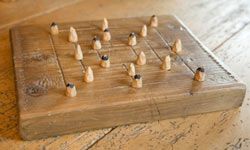You might think math games are just for kids. After all, hundreds of games have been invented to get children interested in arithmetic, and game-based math exercises are popular in many schools. For example, the Everyday Mathematics curriculum, taught in 220,000 U.S. classrooms, uses progressively harder games to supplement math drills. The games have proven effective at helping students permanently improve their math skills. And even simple board games like Chutes and Ladders can help young children learn to count.
Other math games, however, can be enjoyed by players of any age. Many adults, for example, play challenging math games in order to keep their minds sharp as they grow older. Most just like them because they're fun. And they offer keen competition and social interaction, too.
Advertisement
Games involving math force you to use your brain's full power, and some have been challenging people for centuries -- an Egyptian papyrus from 1850 B.C., for example, contained a form of mathematical game. The math games on this list may test your agility at using numbers, or teach math ideas and functions as you play. Either way, get ready to use your noggin.



